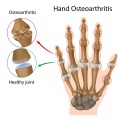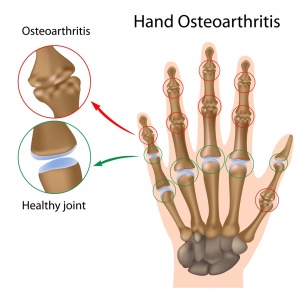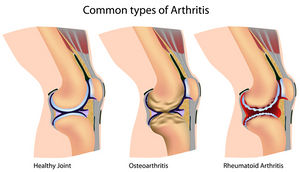Osteoarthritis
Osteoarthritis (OA) is the most common joint disorder affecting 10% to 20% of people over the age of 60 worldwide. It is not a new disease, the degeneration that it causes is observed in the skeletons of dinosaurs, prehistoric humans, and in the skeletons of most vertebrates including those living in the sea. Osteoarthritis is considered a wear-and-tear arthritis. The joints affected are typically those that have been injured or stressed over a long period of time. It most often presents is older adults and seniors. [1]
|
Osteoarthritis | |
| Causes | Injuries and repetitive strain, Environmental Toxins, Environmental Toxins, Infections, Stress |
|---|---|
| See Also | Musculoskeletal Conditions, Arthritis, Obesity, Anemia |
| Books | Books on Muscle, Joint and Bone Conditions |
| Articles | Articles on Musculoskeletal Conditions |
Naturopathic Assessment
Causal Factors
| Article | The Effect of Nutritional Supplements on Osteoarthritis , Alt Med;2004;Vol9(3) |
|---|
| Article | Efficacy and Safety of Meriva®, a Curcumin-phosphatidylcholine Complex, during Extended Administration in Osteoarthritis Patients , Alt Med; 2010;Vol15(4) |
|---|
| Check out this book | Arthritis Survival: The Holistic Medical Treatment Program for Osteoarthritis |
|---|
During a naturopathic assessment you are looking to identify the degree of injury to the affected joint(s), the factors that initially contributed to the injury, and those behaviours or activities that worsen the existing condition.
Lifestyle
- As OA is a condition that is due mainly to wear and tear. Factors such as excessive weight-bearing activity, impact sports, and/or repetitive use of a joint, can cause osteoarthritis and lead to the acceleration of joint deterioration.[2], [3]
- Regular exercise is important in the prevention and treatment of OA. Exercise feeds the cartilage with nutrients and oxygen and ensures ongoing flexibility and movement. The best exercises for preventing OA include walking, swimming, cross-country skiing and cycling as they move the joints through their natural rotation without pain.
| Check out this book | The Anti-Inflammation Diet and Recipe Book: Protect Yourself and Your Family From Heart Disease, Arthritis, Diabetes, Allergies - and More |
|---|
- Certain foods are associated with accelerated joint degeneration. Plants in the nightshade family such as tomato, eggplant, potato and tobacco, have a high alkaloid content. Alkaloids can inhibit normal collagen repair and contribute to systemic inflammation which can exacerbate joint degeneration.[2]
- A high-protein diet, as well as other dietary intake that leads to the acidification of the blood, tends to cause the removal of calcium from bone to buffer this acid. This can result in the deposition of calcium in joints, leading to the formation of hydroxyapatite crystals. Such crystals can increase the friction within the joints and accelerate cartilage degeneration.
- Food intolerances can lead to increased levels of inflammation can can contribute to the exacerbation of OA.
Social
- Demographics
- Due to the degenerative nature of OA, it is more common as we age, existing to some degree in all people over age 65. Women are effected at a higher rate than men, and people of African descent more than others.[2]
- Psychological stress is associated with the aggravation of OA.[4]
- Lowering stress and anxiety causes a decrease in the release of inflammatory hormones, leading to decreased pain and increased healing.
Environmental
- Toxins such as heavy metals, pesticides, and chemical pollutants have been shown to cause an inflammatory immune response, leading to the accelerated degeneration of joints and tendons. Such toxins can also impair the function of the organs in the body that eliminate harmful substances. These organs include the liver, intestines, lymphatic system, and skin.[5]
- Undischarged toxins can cause inflammation and degenerate joints.[5]
External
- Trauma
- Any trauma or fracture to a joint predisposes it to OA later in life, especially if the joint never properly healed.
Medical Interventions
- Prescription Mediciations
- Non-steroidal anti-inflammatory drugs (NSAIDs) can inhibit collagen matrix synthesis and accelerate collagen matrix destruction.[6]
Diagnostic Testing
- Osteoarthritis is confirmed by x-ray. However, in general, the degree of degeneration seen on x-ray does not correlate well with symptoms.[2] Some people with severe degeneration, as seen on x-ray, experience little pain or discomfort in the joint. Others, who show little degeneration, have severe symptoms.
- OA is not detectable by blood tests[2], yet increased levels of inflammation can be measured by an ESR or C-Reactive Protein (CRP).
Related Symptoms and Conditions
- Fractures
- Obesity is a main contributing factor to osteoarthritis because the extra body weight puts excessive strain on weight bearing joints such as the hips and knees.[2] Maintaining a healthy body weight is a way to both prevent and treat osteoarthritis.
- Anemia can result in increased pain and joint deterioration.
- Arthritis
Characteristics
Osteoarthritis is categorized as either primary, or secondary.
- Primary osteoarthritis is due to wear and tear on the joint that leads to cartilage degeneration, and the subsequent release of enzymes that destroy collagen compounds.[7]
- Secondary osteoarthritis is due to a predisposing abnormality of the joint or surrounding area. Examples of such an abnormality are a previous trauma, fracture, ligament tear, tumor, infection, or crystal deposition in the joint, that has altered or impeded its function and causes degenerative changes.[7]
- General Characteristics
| Article | Recalcitrant Bilateral Osteoarthritis, NDNR [1], 2012 February |
|---|
| Article | The Articular Intraosseous Cyst in Osteoarthritis, 2010 July NDNR |
|---|
- Osteoarthritis tends to affect the weight bearing joints including the hips, spine and knees.
- OA signals a loss of proteoglycans and other cartilage components in the joint and the hardening and formation of bone spurs.
- Damage to the joint occurs partly due to inflammation in the synovial joints.
- The continued degradation of cartilage results in the formation of osteophytes within the joint with accompanying pain, stiffness, joint swelling and deformity.[8]
The symptoms of OA include:
- joint stiffness and impaired mobility
- joint swelling and redness
- joint pain
Naturopathic Treatment
The goal of naturopathic treatment is to support and work in tandem with the healing power of the body and to address the causal factors of disease with individual treatment strategies. Osteoarthritis is typically a degenerative chronic disease. Successful treatment is based on prevention and decreasing those factors that are aggravating the situation. Pain management and decreasing the degree of inflammation are important to slow down the rate of joint deterioration.
It is always advisable to work with a naturopathic doctor before engaging in any treatment plan.
| Article | Frankincense's Efficacy in Treating Osteoarthritis , April 2013 Natural Medicine [2] |
|---|
Home Care
| Article | Hydrotherapy Self-Care in Osteoarthritis: Cooperating with the Healing Power of Nature, Vital Link; 2009 Fall |
|---|
Home Care strategies include:
- Hydrotherapy: Ice, when applied to a joint, will decrease the inflammation by decreasing blood flow to the area. The application of heat to the joint will increase the blood supply to it, thereby facilitating waste removal.[2]
Lifestyle
Lifestyle recommendations include:
- Identify and control food allergies and food intolerances.[9]
- Including a high amount of fruits and vegetables into the diet is therapeutic for OA as these contain antioxidants which help protect against joint degeneration.[7]
- Avoid processed/simple carbohydrates, consume high fiber foods, and to minimize fat intake.[7]
- Avoid foods belonging to the family Solanacea (Nightshades) especially if you find that consumption increases the degree of pain or discomfort.
- Methods of detoxification such as fasting may be helpful for some in order to slow joint degeneration, as they can facilitate the elimination of toxins from the body, and decrease chemical and food allergies that can contribute to OA. Toxins and allergens cause the release of proinflamatory immune cells such as leukotrienes and eosinophils. This leads to systemic inflammation which can accelerate joint degeneration. Fasts should be supervised by a healthcare provider.[5]
- Eliminate alcohol, caffeine and sugar.[9]
- Consume a diet that focuses on whole unprocessed food (whole grains, legumes, vegetables, nuts and seeds).[9]
- Ensure you drink adequate water.
- As OA affects weight bearing joints it is important to maintain a healthy weight. Weight loss reduces the risk of OA and improves symptoms.
| Article | Warm "Hay Baths" for Osteoarthritis, NMJ, [3], 2012 May |
|---|
- Exercise increases the flow of nutrients to the joint, thereby facilitating repair. Low-impact exercise such as walking, swimming, Tai-Chi, or isometric contractions, is preferable as it puts the least amount of strain on the joints.[6], [7]
- Proper posture is important in the prevention and management of OA.
- Rest and Relaxation are important to prevent the progression of osteoarthritis.[9]
Naturopathic Therapies
The prescribing of naturopathic therapies requires the guidance of a naturopathic doctor as it depends on a number of factors including the causal factors, a person's age, prescription medications, other conditions and symptoms and overall health. It is always advisable to work with a naturopathic doctor prior to taking any natural therapies.
Naturopathic Therapies for osteoarthritis include:
- Clinical Nutritional Supplementation includes
- Vitamins such as Vitamin C, Vitamin E,[11] Vitamin B3[8], Vitamin B5, Vitamin B6
- Minerals such as Selenium, Boron, Sulfur, Zinc
- Amino Acids such as Methionine, Cysteine
- Other supplements such as Flaxseed oil, Glucosamine sulfate[8], [12], Chondroitin Sulfate[8], SAME[9], Oleanolic acid[13], bioflavonoids[8], Cod Liver Oil, Digestive Enzymes, Glutathione, Methlysulphonylmethane (MSM), Pregnenolone, Shark Cartilage, Superoxide Dismutase
- Herbs such as
- topically applied Capsicum creams and ointments
- Herbs such as Black Cohosh (Cimicifuga racemosa), Devil's Claw (Harpagophytum procumbens), Turmeric (Curcuma longa), Ginger (Zingiber officinale)[8], Meadowsweet (Filipendula ulmaria), Mistletoe (Viscum album), Incense tree (Boswellia serrate) and Nettle’s.
- anti-inflammatory herbs may help reduce pain and improve joint function.[14], [13].
| Article | Mesotherapy-A holistic and not-so-new approach to managing arthritis pain, Vital Link; 2006 Spring/Summer |
|---|
- Classical homeopathics are beneficial.[8]
- Complex homeopathics can assist in decreasing chronic inflammation and in supporting joint health.
- Acupuncture is used, in this condition, to stimulate the flow of Qi in the joint area thereby relieving the stagnation that is thought to contribute to arthritis.[7]
- From a TCM perspective, arthritis is caused by either a wind-damp-heat impediment, or a wind-cold-damp impediment. The former is characterised by hot, red, painful, swollen joints, a rapid onset, thirst, red tongue, yellow tongue fur, and a rapid pulse. The latter by no sign of heat or swelling, white tongue fur, moderate pulse, a slow onset, and pain that is aggravated by wind type weather.[15]
| Article | Arthritis: Manipulation and Physical Treatment Perspectives, Vital Link; 2006 Spring/Summer |
|---|
- Massage is helpful as it increases local circulation and thus, the flow of nutrients to the area. This speeds the healing process and increases the rate of removal of inflammatory chemicals. It also stimulates the release of enkephalins and endorphins (the body's own pain killers). By these methods, massage relieves stiffness and pain in the muscles surrounding the joint. This leads to increased mobility and range of motion.[2]
References
Co-Authored by:
- Dr. Iva Lloyd, BScH, RPE, ND[4]
- Dr. Raymond Trott, ND
- ↑ Pizzorno Joseph, Murray Michael, Joiner-Bey Herb (2002) The Clinician's Handbook of Natural Medicine, Churchill Livingstone
- ↑ 2.0 2.1 2.2 2.3 2.4 2.5 2.6 2.7 Kendall-Reed P, Reed S (2002) Healing Arthritis, Complementary Naturopathic, Orthopedic and Drug Treatments Quarry Press Inc.
- ↑ Prousky J (2008) Principles and Practices of Naturopathic Clinical Nutrition CCNM Press Inc.
- ↑ Hodgson Brown E. (2001) Healing Joint Pain Naturally, Safe and Effective Ways to Treat Arthritis, Fibromyalgia and Other Joint Diseases Broadway Books.
- ↑ 5.0 5.1 5.2 5.3 Zampieron E, Kamihi E, Goldberg B (1999) Arthritis, an Alternative Medicine Definitive Guide AlternativeMedicine.com Inc.
- ↑ 6.0 6.1 El-Hashemy (2011) Textbook of Naturopathic Family Medicine & Integrative Primary Care: Standards & Guidelines p 373 CCNM Press Inc.
- ↑ 7.0 7.1 7.2 7.3 7.4 7.5 Pizzorno Jr. Joseph E (1999) Texbook of Natural Medicine, Third Ediditon, volume 2. p 1961. Elsevier.
- ↑ 8.0 8.1 8.2 8.3 8.4 8.5 8.6 Sutter Frederick (2000) Natural Therapies for Osteoarthritis Applied Nutritional Science Reports;Vol8.
- ↑ 9.0 9.1 9.2 9.3 9.4 Murray Michael (1996) Encyclopedia of Nutritional Supplements, The Essential Guide for Improving Your Health Naturally Prima Publishing
- ↑ Jwing-Ming Y (1996) Arthritis, the Chinese Way of Healing and Prevention Jamaca Plain
- ↑ Tocopherol in osteoarthritis: a controlled pilot study J Am Geriatr Soc;1978:25(7):328-330.
- ↑ Therapeutic activity of oral glucosamine sulfate in osteoarthritis: a placebo controlled double-bline investigation Clin Ther;1980;3(4):260-272.
- ↑ 13.0 13.1 Lukaczer Dan, Lerman Robert, Darland Gary, Liska DeAnn, Schiltz Barbara, Tipp Matthew, Bland Jeffery (2004) Effects of a reduced iso-alpha-acids (RIAA), rosemary extract, and oleanolic acid supplement on pain in subjects with osteoarthritis (OA). Functional Medicine Research Center
- ↑ Boon Heather, Smith Micheal. (2009) 55 Most Common Medicinal Herbs, Second Edition Institute of Naturopathic Education and Research, Toronto.
- ↑ Riley, D (2003) Treating Pain with Traditional Chinese Medicine Paradigm


